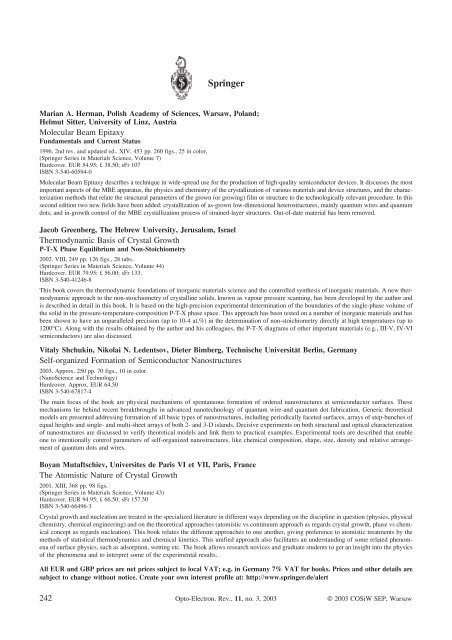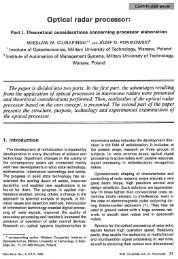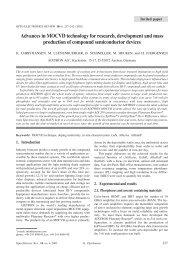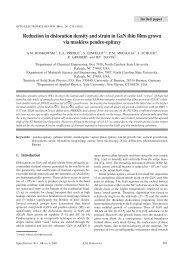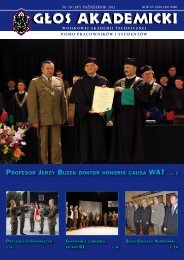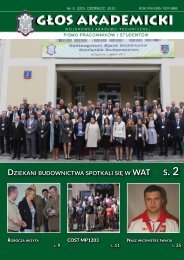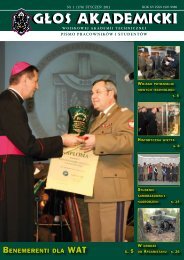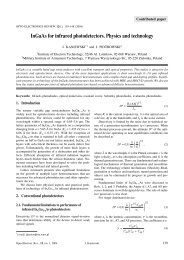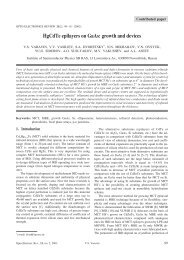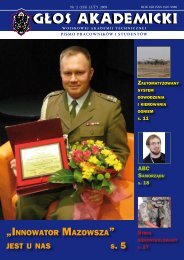Use of two-dimensional matched filters for estimating a length of ...
Use of two-dimensional matched filters for estimating a length of ...
Use of two-dimensional matched filters for estimating a length of ...
You also want an ePaper? Increase the reach of your titles
YUMPU automatically turns print PDFs into web optimized ePapers that Google loves.
SpringerMarian A. Herman, Polish Academy <strong>of</strong> Sciences, Warsaw, Poland;Helmut Sitter, University <strong>of</strong> Linz, AustriaMolecular Beam EpitaxyFundamentals and Current Status1996. 2nd rev. and updated ed.. XIV, 453 pp. 260 figs., 25 in color,(Springer Series in Materials Science, Volume 7)Hardcover. EUR 54.95; £ 38.50; sFr 107ISBN 3-540-60594-0Molecular Beam Epitaxy describes a technique in wide-spread use <strong>for</strong> the production <strong>of</strong> high-quality semiconductor devices. It discusses the mostimportant aspects <strong>of</strong> the MBE apparatus, the physics and chemistry <strong>of</strong> the crystallization <strong>of</strong> various materials and device structures, and the characterizationmethods that relate the structural parameters <strong>of</strong> the grown (or growing) film or structure to the technologically relevant procedure. In thissecond edition <strong>two</strong> new fields have been added: crystallization <strong>of</strong> as-grown low-<strong>dimensional</strong> heterostructures, mainly quantum wires and quantumdots, and in-growth control <strong>of</strong> the MBE crystallization process <strong>of</strong> strained-layer structures. Out-<strong>of</strong>-date material has been removed.Jacob Greenberg, The Hebrew University, Jerusalem, IsraelThermodynamic Basis <strong>of</strong> Crystal GrowthP-T-X Phase Equilibrium and Non-Stoichiometry2002. VIII, 249 pp. 126 figs., 28 tabs.(Springer Series in Materials Science, Volume 44)Hardcover. EUR 79.95; £ 56.00; sFr 133.ISBN 3-540-41246-8This book covers the thermodynamic foundations <strong>of</strong> inorganic materials science and the controlled synthesis <strong>of</strong> inorganic materials. A new thermodynamicapproach to the non-stoichiometry <strong>of</strong> crystalline solids, known as vapour pressure scanning, has been developed by the author andis described in detail in this book. It is based on the high-precision experimental determination <strong>of</strong> the boundaries <strong>of</strong> the single-phase volume <strong>of</strong>the solid in the pressure-temperature-composition P-T-X phase space. This approach has been tested on a number <strong>of</strong> inorganic materials and hasbeen shown to have an unparalleled precision (up to 10-4 at.%) in the determination <strong>of</strong> non-stoichiometry directly at high temperatures (up to1200°C). Along with the results obtained by the author and his colleagues, the P-T-X diagrams <strong>of</strong> other important materials (e.g., III-V, IV-VIsemiconductors) are also discussed.Vitaly Shchukin, Nikolai N. Ledentsov, Dieter Bimberg, Technische Universität Berlin, GermanySelf-organized Formation <strong>of</strong> Semiconductor Nanostructures2003. Approx. 250 pp. 70 figs., 10 in color.(NanoScience and Technology)Hardcover. Approx. EUR 64.50ISBN 3-540-67817-4The main focus <strong>of</strong> the book are physical mechanisms <strong>of</strong> spontaneous <strong>for</strong>mation <strong>of</strong> ordered nanostructures at semiconductor surfaces. Thesemechanisms lie behind recent breakthroughs in advanced nanotechnology <strong>of</strong> quantum wire-and quantum dot fabrication. Generic theoreticalmodels are presented addressing <strong>for</strong>mation <strong>of</strong> all basic types <strong>of</strong> nanostructures, including periodically faceted surfaces, arrays <strong>of</strong> step-bunches <strong>of</strong>equal heights and single- and multi-sheet arrays <strong>of</strong> both 2- and 3-D islands. Decisive experiments on both structural and optical characterization<strong>of</strong> nanostructures are discussed to verify theoretical models and link them to practical examples. Experimental tools are described that enableone to intentionally control parameters <strong>of</strong> self-organized nanostructures, like chemical composition, shape, size, density and relative arrangement<strong>of</strong> quantum dots and wires.Boyan Mutaftschiev, Universites de Paris VI et VII, Paris, FranceThe Atomistic Nature <strong>of</strong> Crystal Growth2001. XIII, 368 pp. 98 figs.(Springer Series in Materials Science, Volume 43)Hardcover. EUR 94.95; £ 66.50; sFr 157.50ISBN 3-540-66496-3Crystal growth and nucleation are treated in the specialized literature in different ways depending on the discipline in question (physics, physicalchemistry, chemical engineering) and on the theoretical approaches (atomistic vs continuum approach as regards crystal growth, phase vs chemicalconcept as regards nucleation). This book relates the different approaches to one another, giving preference to atomistic treatments by themethods <strong>of</strong> statistical thermodynamics and chemical kinetics. This unified approach also facilitates an understanding <strong>of</strong> some related phenomena<strong>of</strong> surface physics, such as adsorption, wetting etc. The book allows research novices and graduate students to get an insight into the physics<strong>of</strong> the phenomena and to interpret some <strong>of</strong> the experimental results.All EUR and GBP prices are net prices subject to local VAT; e.g. in Germany 7% VAT <strong>for</strong> books. Prices and other details aresubject to change without notice. Create your own interest pr<strong>of</strong>ile at: http://www.springer.de/alert242 Opto-Electron. Rev., 11, no. 3, 2003 © 2003 COSiW SEP, Warsaw


